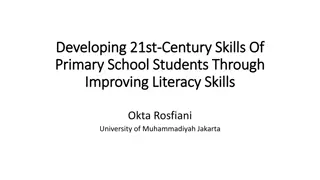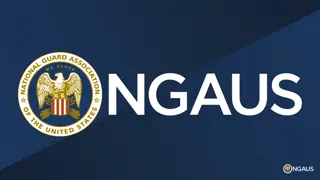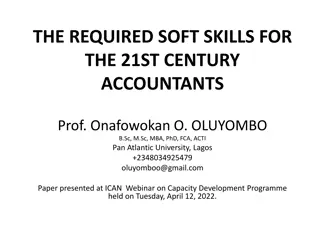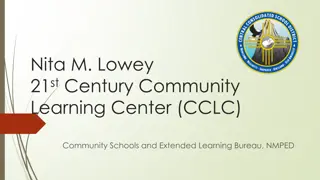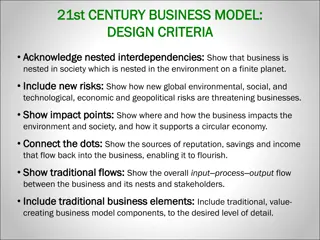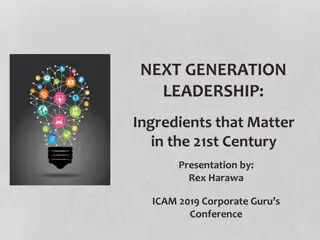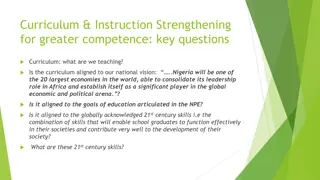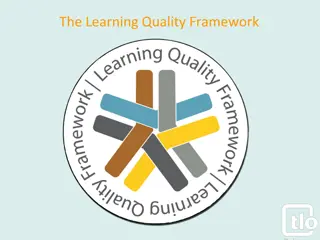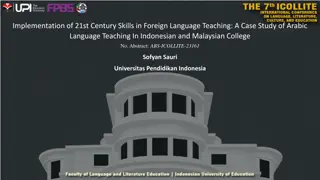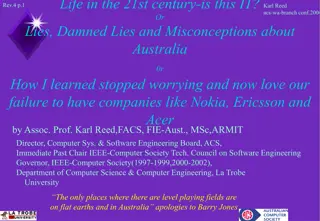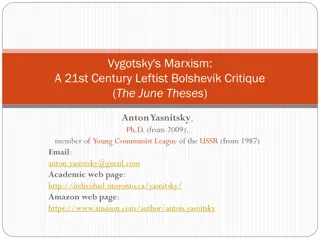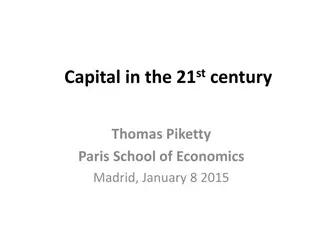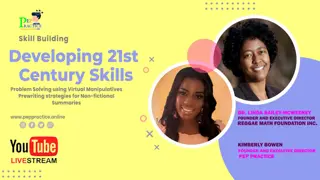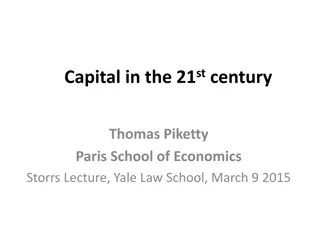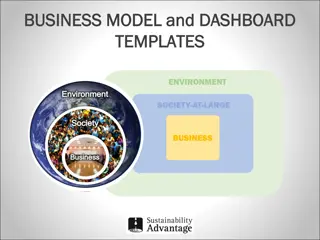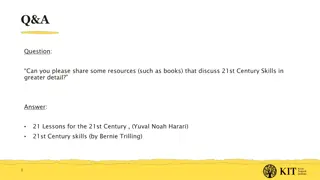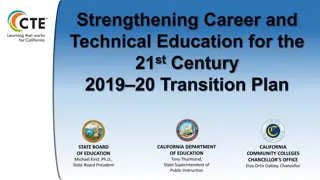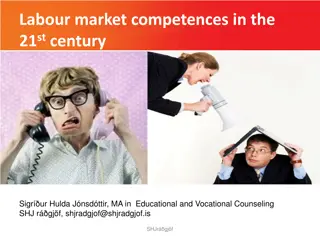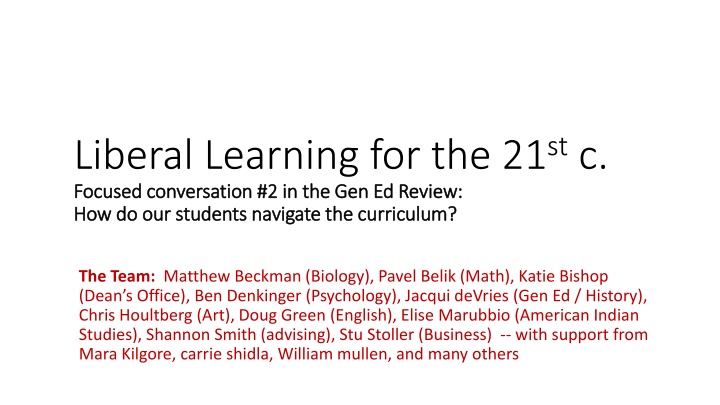
Navigating Curriculum in 21st Century Education
General Education plays a crucial role in guiding students through diverse learning pathways. This focused conversation delves into how students navigate the curriculum amidst changing institutional and external contexts, emphasizing the need for clear programmatic purposes and equitable access to excellence. Faculty-driven student learning outcomes reflect the institution's mission of fostering informed citizens and thoughtful stewards, preparing students for civic engagement, global awareness, vocation, sustainability, and more.
Download Presentation

Please find below an Image/Link to download the presentation.
The content on the website is provided AS IS for your information and personal use only. It may not be sold, licensed, or shared on other websites without obtaining consent from the author. If you encounter any issues during the download, it is possible that the publisher has removed the file from their server.
You are allowed to download the files provided on this website for personal or commercial use, subject to the condition that they are used lawfully. All files are the property of their respective owners.
The content on the website is provided AS IS for your information and personal use only. It may not be sold, licensed, or shared on other websites without obtaining consent from the author.
E N D
Presentation Transcript
Liberal Learning for the 21stc. Focused conversation #2 in the Gen Ed Review: Focused conversation #2 in the Gen Ed Review: How do our students navigate the curriculum? How do our students navigate the curriculum? The Team: Matthew Beckman (Biology), Pavel Belik (Math), Katie Bishop (Dean s Office), Ben Denkinger (Psychology), Jacqui deVries (Gen Ed / History), Chris Houltberg (Art), Doug Green (English), Elise Marubbio (American Indian Studies), Shannon Smith (advising), Stu Stoller (Business) -- with support from Mara Kilgore, carrie shidla, William mullen, and many others
Guiding Philosophy: General Education is more than simply a curriculum; it is possibly the most important manifestation of an institutions educational mission. * should include a clear programmatic purpose, resonate with the institution s distinctive mission, and include transparent, powerful goals and outcomes for student learning needs to provide guided pathways to create equitable access to excellence for all students** should prepare a student for Signature Work*** *Andrea Leskes and Ross Miller, General Education: A Self-Study Guide for Review and Assessment (AACU, 2005), p.3. **Paul L. Gaston, General Education Transformed: How We Can, Why We Must (AACU 2015). ***Carol Geary Schneider, The Leap Challenge, Liberal Education (Winter/Spring 2015)
Why consider revisions now? Don t we have enough change going on at the College? Changing Institutional Contexts: In 2009, the College adopted a new mission statement In 2014, the faculty approved new institutional Student Learning Outcomes (iSLOs) The student body has grown increasingly diverse Institutional assessment data is revealing shortcomings in student achievement in key areas. Changing External Contexts: Since 2002, the political and economic landscape of the country has shifted Since the Great Recession, students and parents place more emphasis on ROI, requiring colleges to rearticulate the benefits of liberal learning High school curriculum has changed during this time ( No Child Left Behind ) Technology has pervaded the educational experience
Student Learning Outcomes Adopted by faculty in December 2014 As INFORMED CITIZENS, students are learning to engage their communities and demonstrate a sense of agency to create change in ethical and informed ways (Civic Engagement/Ethical Reasoning) explain diverse positions and collaborate effectively across social, cultural and geographic differences in local and global contexts (Global Awareness/Intercultural Competence) As THOUGHTFUL STEWARDS, students are learning to critically engage their own beliefs and articulate their gifts and goals for meaningful life and work in a pluralistic context (Vocation/Religious Literacy) identify the broad foundations for sustainable living and apply them in demonstrable ways (Health and Wellness/Sustainability)
Student Learning Outcomes Adopted by faculty in December 2014 As CRITICAL THINKERS, students are learning to use appropriate methods to gather and analyze evidence, identify underlying assumptions, and evaluate competing claims (Critical Thinking / Information Literacy) construct coherent, polished and persuasive arguments, narratives and explications in written, oral and other formats (Writing / Oral Communication) As RESPONSIBLE LEADERS, students are learning to employ the fundamental principles of quantitative literacy to arrive at thoughtful judgments (Quantitative Literacy) articulate and solve problems in creative, analytical, and integrative ways (Problem Solving / Integrative Learning)
Some preliminary conclusions Our curriculum lacks guided pathways and can seem like a checklist of unconnected courses Our iSLOs are not integrated consistently into the curriculum Certain key skills need greater clarity and emphasis (e.g. Critical Reading, Writing-across-the-Curriculum, Quantitative Reasoning, Information Literacy) Some areas of our curriculum need greater clarity (e.g. Modern Language: is the goal language fluency or intercultural competency?) Gen Ed needs built-in flexibility to ensure AU & transfer students meet iSLOs We need to redouble our efforts to have long-term faculty teach our core classes
A Proposed Timeline for Revisions: 2019 2017-18 Implement 2016-17 Design 2015-16 Review
Supporting Data for Focused conversation #2: How do our students navigate the core curriculum? One perspective: The masses of college students are left with a thin veneer of course distribution to cover their essentially vocational education. -- Michael W. Clune, Chronicle of Higher Education (Dec. 6, 2015)
Distribution (LAFs) + Signature Curriculum (REL / KEY) + Skills + Experiences (EM / AUGEX)
Liberal Arts Foundation courses: % of students fulfilling all requirements at Augsburg 45% Fifteen years ago, AP, IB, and PSEO transfer credit was the exception; now it s the norm 40% 35% 30% 25% William Mullen, VP Enrollment Management 20% 15% 10% 5% 0% 2013 2014 2015 Complete all 8 LAFs at Augsburg Complete 5-7 Complete 2-4 Complete 0-1
Transfer Students* *The MN transfer agreement (the Auggie Plan ), signed with area community colleges in June 2015, is expected to boost transfer #s: Fall Day Transfers Only 205 198 178 174 166 163 163 161 158 158 157 2005 2006 2007 2008 2009 2010 2011 2012 2013 2014 2015
Transfer Students: nowmake up 35% or more of our undergraduate student population Fall 2015 -- All Students 23% 11% Transfers Transfers with Associate's Degree
Effective Writing: More than 40% of students do not take ENL 111 at Augsburg 50% 45% 40% 35% 30% 25% 20% 15% 10% 5% 0% ENL 101 (Developmental) ENL 111 (Effective) ENL 112 (Advanced) Waived (transfer) 2013 2014 2015
Effective Reading? Nearly 40% of first-year students fall in the bottom two quintiles of ACT Reading scores 35% 30% 25% 20% 15% 10% 5% 0% 2011 2012 2013 2014 2015 Quintile 1 ( 18) Quintile 2 (19-20) Quintile 3 (21-23) Quintile 4 (24-26) Quintile 5 ( 27)
Modern Language Requirement # of Students opting to take a language test through LTI to fulfill Modern Language requirement 50 Most Common Languages: 45 40 Hmong Amharic Somali Arabic Vietnamese Lao Swahili 35 30 25 20 15 10 5 0 2011 2012 2013 2014 2015
Modern Language requirement: % of graduates completing courses at Augsburg 50% 45% 40% 35% 30% 25% 20% 15% 10% 5% 0% 2013 2014 2015 0 courses (waived) 1 course (usually 112) 2 courses (111/112)
Too many requirements? A Sample Comparison of Required Credits for Major / Core* Biology Finance Social Work Psychology History 0% 10% 20% 30% 40% 50% 60% 70% 80% 90% 100% Major Requirements Core Requirements Elective Credit *assuming a mythical student who places into MPG 4/Effective Writing /Modern Language I and has no credits in transfer. This does not include HPE or Augsburg Experience as a credit, since these can be done through non-credit experience.
Instructor Status (Spring 2016): % of Gen Ed courses taught by adjuncts (estimate) Modern Language NSM / lab* NSM Social Sciences Fine Arts Humanities REL 100 ENL 101/111 0% 10% 20% 30% 40% 50% 60% 70% 80% 90% 100% Adjunct Tenure-Track Tenured *NSM / lab courses do not include #s for labs taught by additional professors
Other Models of General Education COLL 100 is about big questions and big ideas the significant concepts, beliefs and creative visions, theories and discoveries that have shaped our understanding of the world. COLL 150 asks students to engage in deep readings and group discussions of texts, data, or methods of inquiry from the discipline. COLL 200 courses are about the academic disciplines about where their practices intersect and diverge, the various ways they approach questions of evidence and conclusions, and how, together, they comprise the broader framework of the liberal arts. William and Mary s new College Curriculum approved by faculty in 2013 and scheduled for adoption on 2015: focuses on skills, methods, connections and integration



